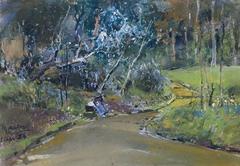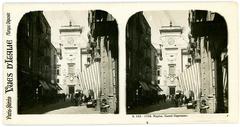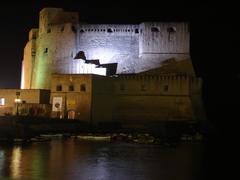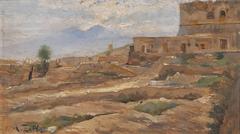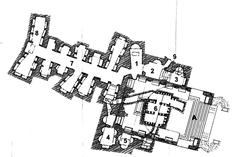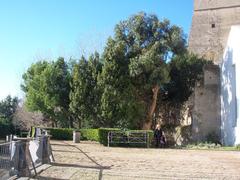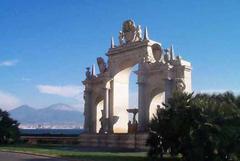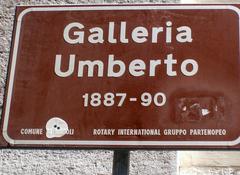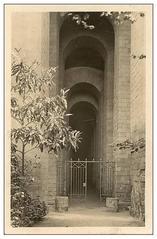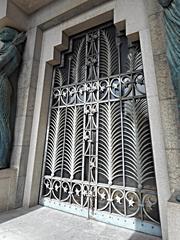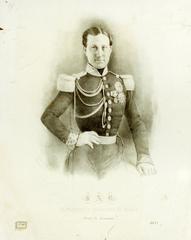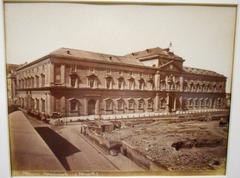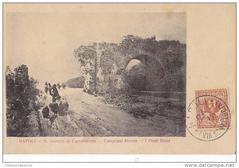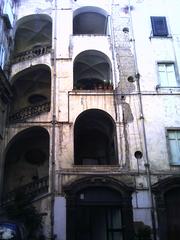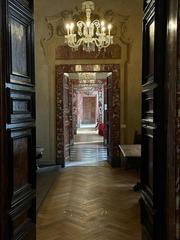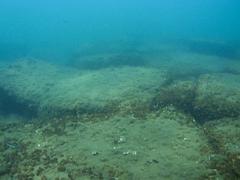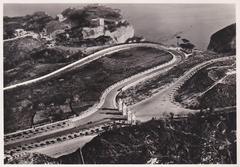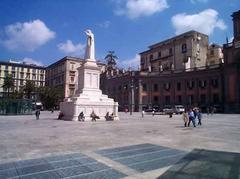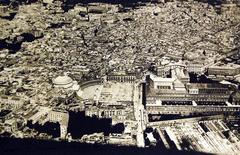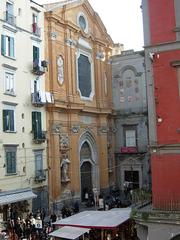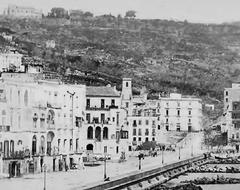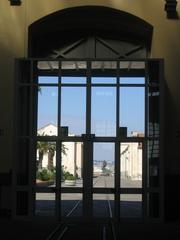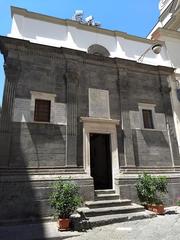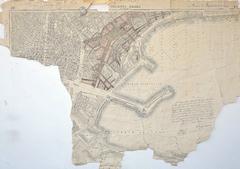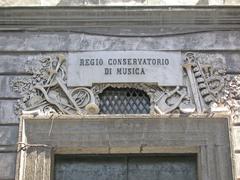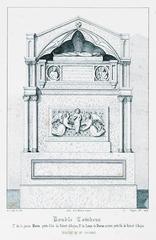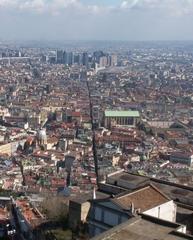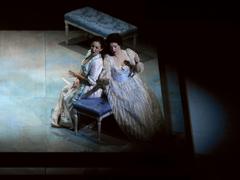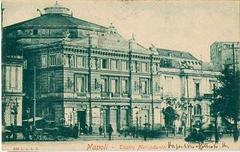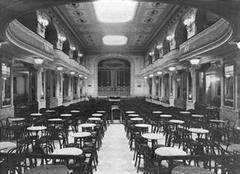Comprehensive Guide to Visiting Castel Nuovo, Naples, Italy
Date: 17/07/2024
Introduction
Nestled in the heart of Naples, Italy, Castel Nuovo, also known as Maschio Angioino, stands as a monumental testament to the city’s rich history and cultural heritage. Constructed in 1279 under the auspices of Charles I of Anjou and designed by French architect Pierre de Chaule, this medieval castle has witnessed the ebbs and flows of political power, royal patronage, and artistic evolution over centuries (Naples Tourism). Serving various roles—from a royal residence to a military fortress—Castel Nuovo is not just an architectural marvel but also a cultural beacon that encapsulates significant historical events, including the abdication of Pope Celestine V in 1294 and the triumphant entry of Alfonso V of Aragon in 1442 (History of Naples, Aragonese Architecture). Today, it houses the Museo Civico, offering visitors a comprehensive exploration of Naples’ artistic and historical tapestry. This guide aims to provide detailed insights into the history, architectural evolution, and visitor experience of Castel Nuovo, making it an indispensable resource for history enthusiasts and tourists alike.
Table of Contents
- Introduction
- History of Castel Nuovo
- Key Historical Events
- Architectural Evolution
- Cultural Significance
- Visitor Experience
- Museo Civico
- Nearby Attractions
- Dining and Refreshments
- Souvenirs and Shopping
- Safety and Security
- Language and Communication
- Weather Considerations
- Special Events and Exhibitions
- Emergency Contacts
- FAQ
- Conclusion
History of Castel Nuovo
Origins and Construction
Castel Nuovo, located in Naples, Italy, began construction in 1279 under Charles I of Anjou. Designed by French architect Pierre de Chaule, it was completed in 1282. Its strategic location overlooking the Gulf of Naples made it a significant military and political stronghold (Naples Tourism).
Angevin Period
During the Angevin period, Castel Nuovo served as the primary residence of the royal family and a center for political and cultural activities. One of the most notable events was the visit of Pope Celestine V in 1294, who abdicated the papacy within the castle’s walls, leading to the election of Pope Boniface VIII (History of Naples).
Aragonese Renovations
In 1442, Alfonso V of Aragon conquered Naples and initiated significant renovations, incorporating Renaissance elements. The Triumphal Arch, designed by Francesco Laurana and Pietro di Martino, celebrated Alfonso’s victorious entry into Naples (Aragonese Architecture).
Spanish Viceroyalty
During the early 16th century, Castel Nuovo continued to play a crucial role as the residence of the Spanish viceroys and a military fortress. The castle’s defenses were strengthened to withstand modern artillery and it was used as a prison (Spanish Naples).
Bourbon Restoration
In the 18th century, the Bourbon dynasty’s restoration brought another phase of renovation to Castel Nuovo. King Charles III of Spain undertook efforts to restore and preserve the castle’s historical and architectural heritage (Bourbon Naples).
Modern Era and Preservation
The 19th and 20th centuries saw various restoration projects to preserve Castel Nuovo’s historical and architectural integrity. The castle was declared a national monument in 1872 and today houses the Museo Civico (Museo Civico).
Key Historical Events
- 1294 - Pope Celestine V abdicates the papacy at Castel Nuovo.
- 1442 - Alfonso V of Aragon conquers Naples and renovates the castle.
- 1503 - The Spanish Viceroyalty begins, and the castle serves as the viceroy’s residence.
- 1734 - Charles VII of Naples initiates restoration efforts during the Bourbon period.
- 1872 - Castel Nuovo is declared a national monument.
Architectural Evolution
The architectural evolution of Castel Nuovo reflects the various dynasties and historical periods it has witnessed. The original Gothic design by Pierre de Chaule was characterized by its fortified walls and towers. The Aragonese renovations introduced Renaissance elements, most notably the Triumphal Arch. The Spanish period saw further fortifications to adapt to modern artillery, while the Bourbon restoration focused on preserving and enhancing the castle’s historical features (Architectural History).
Cultural Significance
Castel Nuovo has played a pivotal role in the cultural and political history of Naples. It has been a royal residence, a military fortress, and a center for political power. The castle’s rich history is reflected in its architecture, artworks, and numerous historical events. Today, it stands as a symbol of Naples’ historical legacy and cultural heritage (Cultural Significance).
Visitor Experience
Tickets and Visiting Hours
Visitors can purchase tickets at the entrance or online. The castle is open from 9 AM to 7 PM, with the last entry at 6 PM. It is closed on Tuesdays.
Guided Tours and Special Events
Guided tours are available, offering detailed explanations of the castle’s architectural features and historical significance. Special events, such as historical reenactments and art exhibitions, are held throughout the year.
Travel Tips and Nearby Attractions
For the best experience, visit early in the morning to avoid crowds. Nearby attractions include the Royal Palace of Naples and the Naples National Archaeological Museum. Public transportation options and parking facilities are available.
Museo Civico
Historical Significance
The Museo Civico, housed within the iconic Castel Nuovo, is a treasure trove of historical artifacts and artworks that reflect the rich cultural heritage of the region. The museum was established to preserve and showcase the historical and artistic legacy of Naples, making it an essential destination for history enthusiasts.
Architectural Marvels
The architecture of Castel Nuovo itself is a significant attraction. The castle features a blend of medieval, Renaissance, and Baroque architectural styles, reflecting the various periods of its construction and renovation. Visitors to the Museo Civico can marvel at the Triumphal Arch, a Renaissance masterpiece added in the 15th century to commemorate the entry of Alfonso V of Aragon into Naples.
Art Collections
The Museo Civico boasts an extensive collection of artworks spanning several centuries. The museum’s galleries are home to paintings, sculptures, and decorative arts from the medieval period to the 19th century. Notable works include paintings by renowned artists such as Mattia Preti, Luca Giordano, and Francesco Solimena.
Archaeological Exhibits
In addition to its art collections, the Museo Civico features a range of archaeological exhibits. These exhibits include artifacts from ancient Greek and Roman civilizations, reflecting Naples’ historical significance as a major center of the ancient world.
Frescoes and Decorative Arts
The museum’s collection of frescoes and decorative arts is another highlight. The Sala dei Baroni, or Hall of the Barons, is particularly noteworthy for its stunning frescoes depicting scenes from classical mythology and Neapolitan history.
Temporary Exhibitions
The Museo Civico regularly hosts temporary exhibitions that highlight specific aspects of Naples’ cultural heritage or feature works by contemporary artists. Information about current and upcoming exhibitions can be found on the museum’s official website.
Educational Programs
The Museo Civico offers a range of educational programs designed to engage visitors of all ages. These programs include guided tours, workshops, and lectures that provide in-depth insights into the museum’s collections and the history of Naples. More details about these programs can be accessed on the museum’s education page.
Visitor Information
Opening Hours and Tickets
The Museo Civico is open from Tuesday to Sunday. Opening hours are 9 AM to 6 PM from April to October, and 9 AM to 5 PM from November to March. General admission is €10, with discounts available for students and seniors. Free admission is offered on the first Sunday of each month. It is advisable to check the museum’s official website for the most up-to-date information on opening hours and ticket prices.
Accessibility
The Museo Civico is committed to providing an accessible experience for all visitors. The museum is equipped with ramps and elevators to accommodate visitors with mobility impairments. For more information on accessibility services, visit the museum’s accessibility page.
Visitor Tips
- Plan Ahead: To make the most of your visit, consider booking tickets in advance and checking the schedule for any special exhibitions or events.
- Guided Tours: Taking a guided tour can enhance your experience by providing detailed information about the exhibits and the history of Castel Nuovo.
- Photography: Photography is allowed in most areas of the museum, but flash photography and tripods are typically prohibited. Be sure to check the museum’s photography policy before your visit.
- Gift Shop: The museum’s gift shop offers a variety of souvenirs, including books, postcards, and replicas of artworks. It’s a great place to find unique mementos of your visit.
Nearby Attractions
While visiting the Museo Civico, consider exploring other nearby attractions in Naples, such as the historic center of Naples, Piazza del Plebiscito, the Royal Palace of Naples, and the San Carlo Theatre. For more information, visit the Naples tourism website.
Dining and Refreshments
While there are no dining facilities within Castel Nuovo itself, the surrounding area is replete with cafes, restaurants, and gelaterias. For a quick bite, try the local pizzerias offering authentic Neapolitan pizza. For a more leisurely meal, several restaurants nearby serve traditional Italian and Mediterranean cuisine. It is advisable to make reservations, especially during peak hours.
Souvenirs and Shopping
The museum shop at Castel Nuovo offers a variety of souvenirs, including books, postcards, and replicas of historical artifacts. These items make for excellent mementos of your visit. Additionally, the nearby Via Toledo is a bustling shopping street where you can find a wide range of local crafts, fashion, and gifts.
Safety and Security
Castel Nuovo is generally a safe place to visit, but it is always wise to remain vigilant, especially in crowded areas. Keep an eye on your belongings and be aware of your surroundings. The museum has security personnel and surveillance systems in place to ensure the safety of visitors and exhibits.
Language and Communication
While Italian is the primary language spoken in Naples, many staff members at Castel Nuovo speak English and other major languages. Signage and informational materials are often available in multiple languages. However, learning a few basic Italian phrases can enhance your experience and interactions with locals.
Weather Considerations
Naples enjoys a Mediterranean climate, with hot summers and mild winters. If visiting during the summer months, wear light clothing, stay hydrated, and use sunscreen. In the winter, a light jacket or sweater is usually sufficient. Always check the weather forecast before your visit and plan accordingly.
Special Events and Exhibitions
Castel Nuovo frequently hosts special events, temporary exhibitions, and cultural performances. These events can provide a unique and enriching experience beyond the standard visit. Check the official website or local event listings for information on upcoming events during your visit.
Emergency Contacts
In case of emergencies, the local emergency number in Italy is 112. The museum staff can also assist with any immediate concerns or medical issues. It is advisable to have travel insurance that covers medical emergencies and to carry a copy of your insurance details.
FAQ
- What are the visiting hours for Castel Nuovo?
- The castle is open from 9 AM to 7 PM, with the last entry at 6 PM. It is closed on Tuesdays.
- How much are tickets to Castel Nuovo?
- Ticket prices vary, but general admission is around €6.
- Are guided tours available at Castel Nuovo?
- Yes, guided tours are available and can be booked in advance.
- What are the best times to visit Castel Nuovo?
- Early morning visits are recommended to avoid crowds.
- How can I buy tickets for Castel Nuovo?
- Tickets can be purchased at the museum’s entrance or online through the museum’s official website.
Conclusion
In conclusion, Castel Nuovo (Maschio Angioino) in Naples is more than just a historical site; it is a living archive that encapsulates the cultural and political legacy of the city. From its initial construction under Charles I of Anjou to its various phases of renovation and restoration under different dynasties, the castle has continually evolved, reflecting the diverse architectural styles and historical epochs it has witnessed (Spanish Naples, Bourbon Naples). Today, as the home of the Museo Civico, it offers an enriching experience that includes an extensive collection of art, archaeological exhibits, and educational programs, making it a must-visit destination for anyone interested in Naples’ storied past (Museo Civico). Whether you are exploring the Renaissance Triumphal Arch, marveling at the frescoes in the Sala dei Baroni, or simply soaking in the panoramic views of the Gulf of Naples, a visit to Castel Nuovo promises a deep dive into the historical and cultural essence of Naples. Don’t forget to plan your visit in advance, take advantage of guided tours, and explore the nearby attractions to make the most of your trip.
References
- Exploring Castel Nuovo - History, Tickets, and Visitor Tips for Naples’ Iconic Castle, 2023, Naples Tourism https://www.naples-tourism.com/castel-nuovo
- History of Naples, 2023, History of Naples https://www.historyofnaples.com/castel-nuovo
- Aragonese Architecture, 2023, Aragonese Architecture https://www.aragonese-architecture.com/castel-nuovo
- Spanish Naples, 2023, Spanish Naples https://www.spanish-naples.com/castel-nuovo
- Bourbon Naples, 2023, Bourbon Naples https://www.bourbon-naples.com/castel-nuovo
- Museo Civico, 2023, Museo Civico https://www.museocivico.com/castel-nuovo
